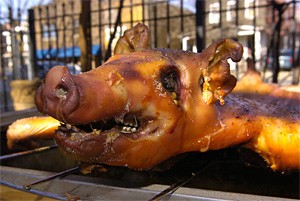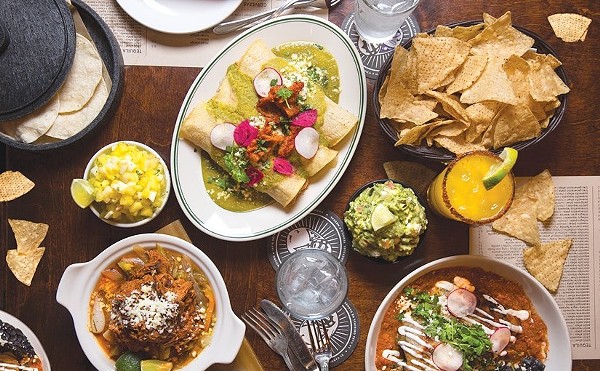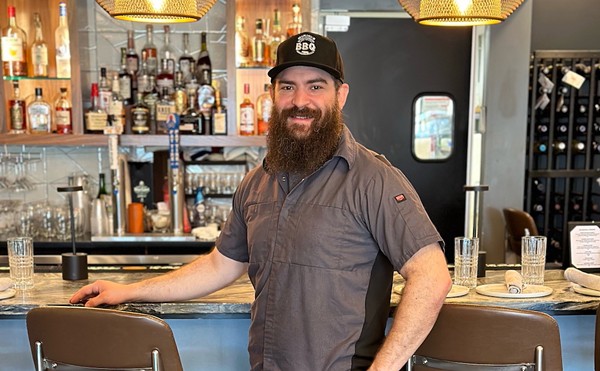Crisp, crackling, and sizzling hot, my soon-to-be-dinner stares up at me from its final resting place on Lolita's stainless-steel counter. It's a thought-provoking moment, actually. On one hand, this beautifully roasted critter, fresh from a field in Wayne County, could be the very Poster Pig for the "farm-to-table" movement. On the other hand, with those fixed blue eyes, tiny hooves, and curly tail still intact, he looks considerably more like Babe than a blue-plate special.
But does this mean I won't savor each and every bite? Hah. I am Carnivore; hear me roar.
There's still work to be done though, if this little piggy will be my dinner, as signaled by the approach of a knife-wielding Matt Harlan, Lolita's chef du cuisine. "The first cut is the deepest," he says without irony, grabbing the beast by the snout and letting the blade slip through the neck. Then, with a deft twist of the wrist, he separates the head from the body and places it off to one side.
"Show me the pork cheeks," I ask greedily, and Harlan obliges by peeling back layers of skin and fat until the outline of the jawbone is visible. There, like a small brown nut connecting top jaw to bottom, rests the tiny cheek muscle. Harlan scoops it out with his index finger and hands it over. It melts on my tongue like butter.
This moment might be the high point of my recent Tuesday at Lolita, a day that found me following the progress of the weekly pig roast from tip to tail. Since that day, I've shared snippets of my observations with several acquaintances, including some food-savvy friends. Their response is generally the same: a little shudder, a nervous giggle, a brief averting of the eyes. I take it as a measure of how far removed we've become from the sources of our sustenance. Evidence that pork comes from an actual pig is somehow kind of shocking.
But my motivation for observing the event was more than just unnerving my acquaintances. Basically, I wanted to know what chefs know: the heft and hue of a dressed piglet; the secrets of seasoning and slow roasting; the ways the final product is apportioned and presented. Plus, of course, I really like pork.
I arrive at 11:30 a.m., a full five and a half hours before the first happy-hour bargain-seeker wanders in. But my arrival has been preceded by that of a free-range, Amish-raised pig. Barely three feet long from snout to corkscrew tail, the cleaned-and-dressed suckling weighs in at around 28 pounds. He cost the restaurant nearly $90.
Once roasted, the animal will yield about 20 eight-ounce servings, Harlan estimates. Paired with appropriate sides, he'll price them at $19 each. The markup reflects not only Lolita's considerable cachet, but the extensive time and labor involved in the process.
Still, Harlan seems upbeat as he hauls the heavy roasting box out of the basement. "I'm so glad Michael decided to do these," Harlan says, referring to his boss, Mike Symon, owner and executive chef of Lolita and her downtown sister, Lola. "It's fun for me, the meat's delicious, and even if we only sell 12 or 15 orders, it's well worth the trouble."
The first step is slicing through the pig's undercarriage with a long serrated knife, so the carcass can be laid open like a book. Because the meat is so intensely marbled, Harlan says, only kosher salt and freshly ground pepper are required for seasoning. The salt, he throws on by the handful; the pepper, he applies by way of a well-worn brass mill that he twists furiously. Then Harlan hoists the pig in his arms and carries it out to the patio behind the restaurant, where the pine-and-stainless-steel roasting box awaits.
In goes the pig, rib-side-up, onto a wire rack; a matching rack is laid on top and secured to the bottom one by three S-hooks. Not only does this arrangement keep the animal lying reasonably flat to promote even cooking, but it makes it possible for Harlan and an assistant to flip the beast over when the time arrives. Then on goes the stainless-steel cover, recessed like a Dutch-oven lid, to hold the requisite 20 pounds of charcoal. After a year of these weekly pig roasts, the cover is appropriately beat-up, so Harlan tosses on a couple of rusty 10-pound weights and a pair of rocks to ensure a tight seal.
By 12:20 p.m., the two stacks of coals are glowing, and Harlan spreads them out with a rake. In the next three and a half hours, he'll add approximately 30 additional pounds of charcoal in 5- to 10-pound increments. That will keep the temperature inside the box steady at around 350 degrees.
We wander off to let the pig and the flames forge their mysterious synergy. Other than giving off the occasional whiff of l'aire du campfire, the actual roasting process is kind of a bore. That changes at 4 p.m. though, when Harlan raises the lid and prepares to turn the pig.
Sheets of fragrant steam come rushing out, turning the bleak, gray patio into a slice of pig heaven. Pools of mahogany juices have gathered in the rib cavity, and the skin has been transformed into burnished gold. We stand briefly in mute admiration of this primordial miracle. Then Harlan and his helper flip the pig, and the chef scores the paler back skin into a series of neat diamonds.
An hour more, and it is done. The meat is carried into Lolita's open kitchen and settled on the countertop, where Harlan removes the head and carves the remainder into large portions — ribs, shoulder, loin, and butt — setting aside the head, legs, and miscellaneous scraps for other uses.
"Some of this meat we'll use for the pulled-pork pizza; some of it will end up in the pork ragu, for the gnocchi; and some of the bones, I'll turn into stock for sauces and demiglace," he explains. The best bits, though — a couple of dainty ribs, a morsel of fat-lined skin, and mounds of tender meat — are destined for diners' plates, where tonight they're joined by mascarpone-enriched polenta and a drizzle of salsa verde, a blend of finely diced parsley, garlic, shallots, chile flakes, lemon zest, and EVOO.
On top of my plate, Harlan also adds three golden diamonds of deep-fried skin. He doesn't generally serve the cracklings — "Most people won't eat them," he says with what seems like true regret — but he knows I'm not one of those. Crunchy yet stunningly rich, they pair fabulously with a glass of flowery French Cinsault.
Later in the evening, as the night winds down, Harlan reports he's sold 19 of the 21 portions, with two left over for the staff to nibble on.
"You can always tell when it's been a good one," he says approvingly. And by all measures, this little piggy kicked butt.










